Hartington City Hall and Auditorium on:
[Wikipedia]
[Google]
[Amazon]
The Hartington City Hall and Auditorium, also known as the Hartington Municipal Building, is a city-owned, brick-clad, 2-story center in
 This paved the way for the Chicago, St. Paul, Minneapolis and Omaha Railway (later
This paved the way for the Chicago, St. Paul, Minneapolis and Omaha Railway (later  In 1921, the city council selected William L. Steele to be the architect for the building. Trained at the
In 1921, the city council selected William L. Steele to be the architect for the building. Trained at the  Steele’s skill with Prairie Style designs and his success in interesting clients had markedly increased as a result of his three-year collaboration with famous Minneapolis-based architect
Steele’s skill with Prairie Style designs and his success in interesting clients had markedly increased as a result of his three-year collaboration with famous Minneapolis-based architect 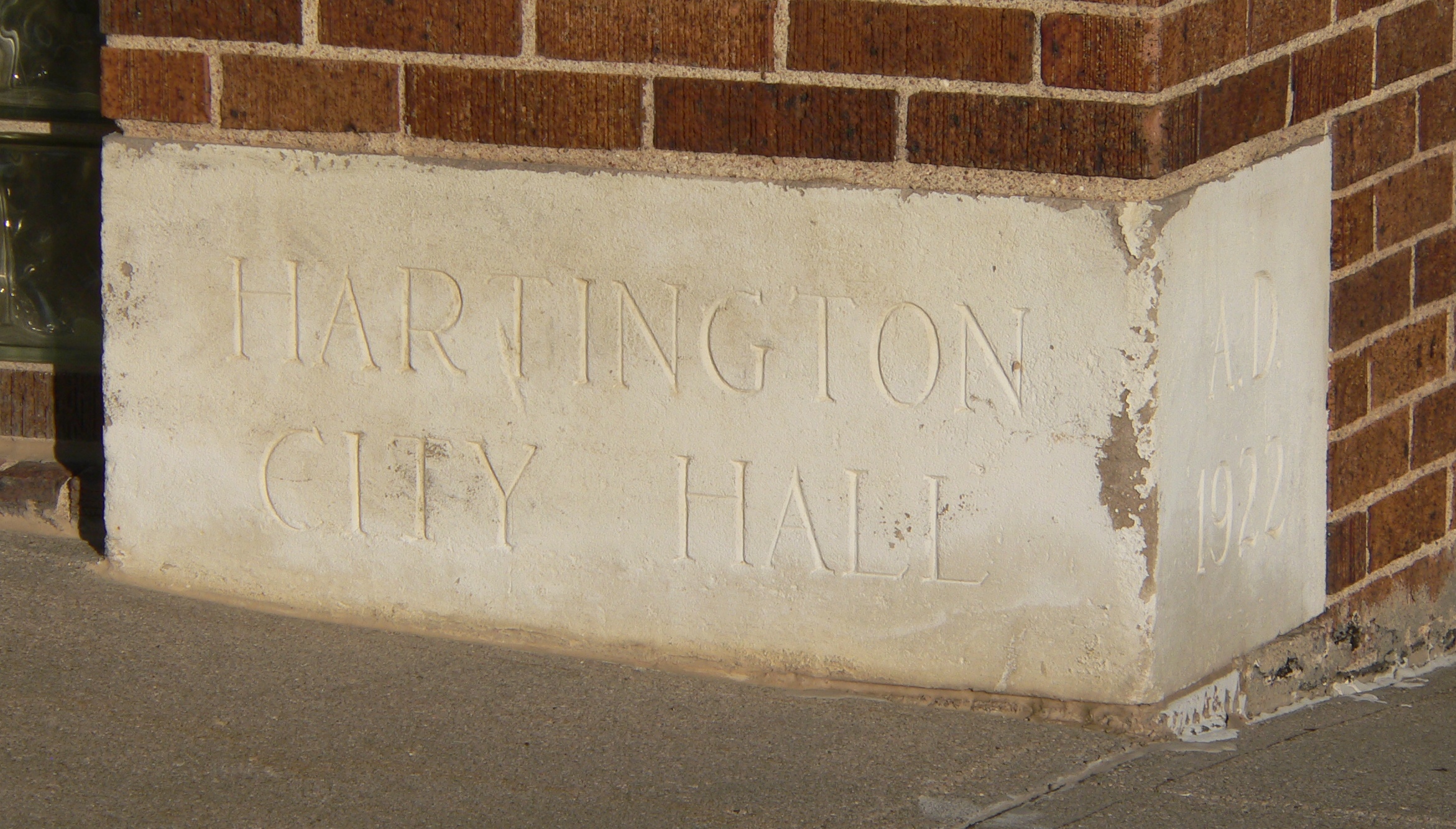 The leaders of Hartington would have been familiar with these and other Steele-designed Prairie School style buildings; there would be no surprise in what they were getting. What is surprising is that they agreed to the progressive design. There was considerable public outcry against the Woodbury County Courthouse just five years earlier (including demands from one group for “a courthouse of ordinary and usual design”), but no record of dissent in Hartington. This design “as compared to other known civic buildings in the surrounding counties, stands as a progressive building in an otherwise conservative community.”
Steele drew up initial plans in 1921, then made revisions at the request of the city council. The council accepted the revised plans in January 1922, including space for the auditorium, city offices, fire house, and the
The leaders of Hartington would have been familiar with these and other Steele-designed Prairie School style buildings; there would be no surprise in what they were getting. What is surprising is that they agreed to the progressive design. There was considerable public outcry against the Woodbury County Courthouse just five years earlier (including demands from one group for “a courthouse of ordinary and usual design”), but no record of dissent in Hartington. This design “as compared to other known civic buildings in the surrounding counties, stands as a progressive building in an otherwise conservative community.”
Steele drew up initial plans in 1921, then made revisions at the request of the city council. The council accepted the revised plans in January 1922, including space for the auditorium, city offices, fire house, and the 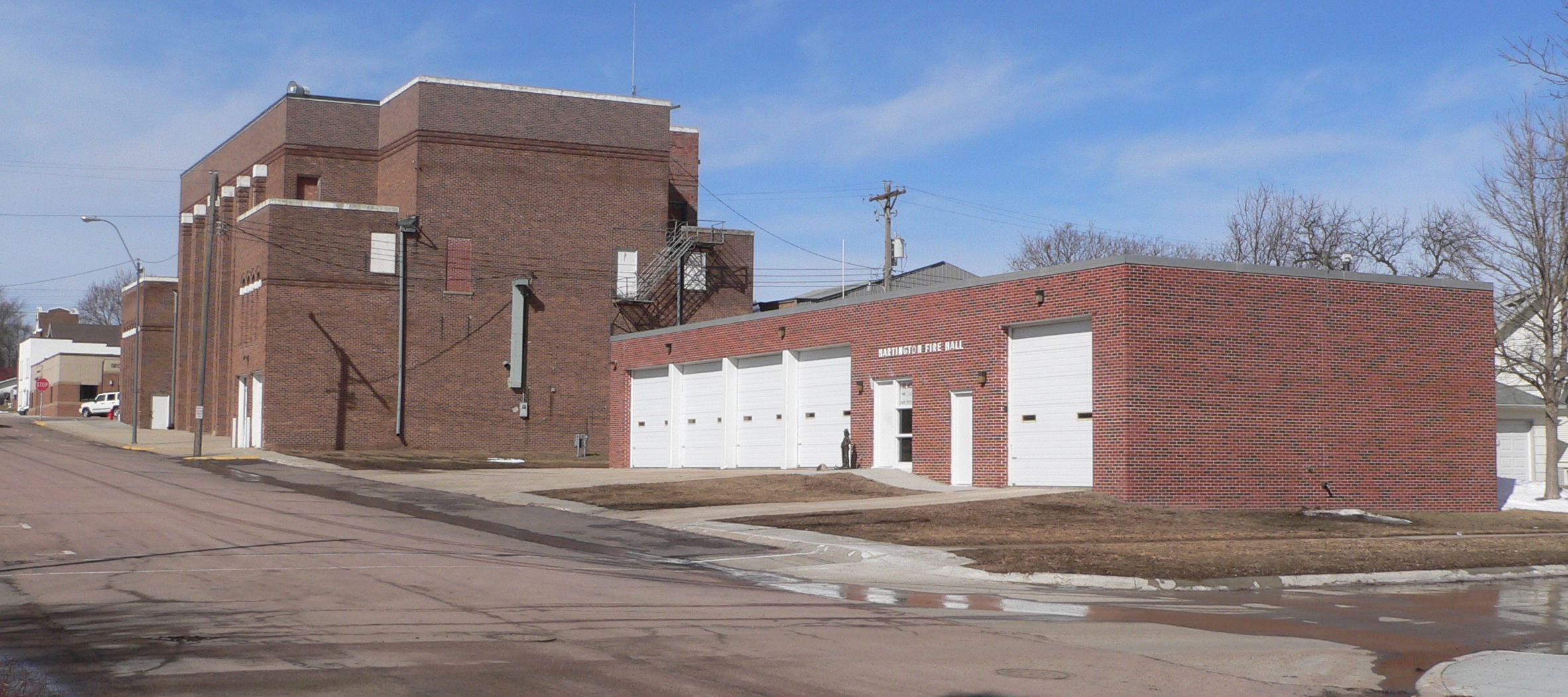 Guarantee Construction Company of Sioux City obtained the contract and began work in the spring of 1922, with the cornerstone laid on June 7. Henry Mahlsted served as Guarantee's superintendent of construction, hiring local labor to do most of the work. The building was completed in January at a cost of $65,000, and the city council officially accepted the building on January 16, 1923. This was followed on January 30 by the official dedication ceremonies, featuring speeches, displays of local talent, and a free dance. On February 1, the ''Hartington Herald'' gushed that it had been a “most important event...attended by thousands of people.... The new building is one of the finest of its kind in the state... and will be a credit and an ornament to this community for many years to come.”
Over the decades, the auditorium has hosted dances, athletic competitions, theatrical, musical, and other events. County-wide eighth grade graduation ceremonies were held there until the late 1940s.
The building is still owned by the City of Hartington, and has recently been renovated. Over the years, many of the windows have been filled in with white stucco, and a new entrance door leading to the basement has been cut into the south facade. The upper auditorium level is currently used primarily for basketball, volleyball, and other recreational activities, while the lower armory level now consists of a meeting room with adjacent kitchen, available for rent through the city. The National Guard armory, city offices, and volunteer fire department have relocated. The new fire house is next door to the east on Centre Street.
Guarantee Construction Company of Sioux City obtained the contract and began work in the spring of 1922, with the cornerstone laid on June 7. Henry Mahlsted served as Guarantee's superintendent of construction, hiring local labor to do most of the work. The building was completed in January at a cost of $65,000, and the city council officially accepted the building on January 16, 1923. This was followed on January 30 by the official dedication ceremonies, featuring speeches, displays of local talent, and a free dance. On February 1, the ''Hartington Herald'' gushed that it had been a “most important event...attended by thousands of people.... The new building is one of the finest of its kind in the state... and will be a credit and an ornament to this community for many years to come.”
Over the decades, the auditorium has hosted dances, athletic competitions, theatrical, musical, and other events. County-wide eighth grade graduation ceremonies were held there until the late 1940s.
The building is still owned by the City of Hartington, and has recently been renovated. Over the years, many of the windows have been filled in with white stucco, and a new entrance door leading to the basement has been cut into the south facade. The upper auditorium level is currently used primarily for basketball, volleyball, and other recreational activities, while the lower armory level now consists of a meeting room with adjacent kitchen, available for rent through the city. The National Guard armory, city offices, and volunteer fire department have relocated. The new fire house is next door to the east on Centre Street.
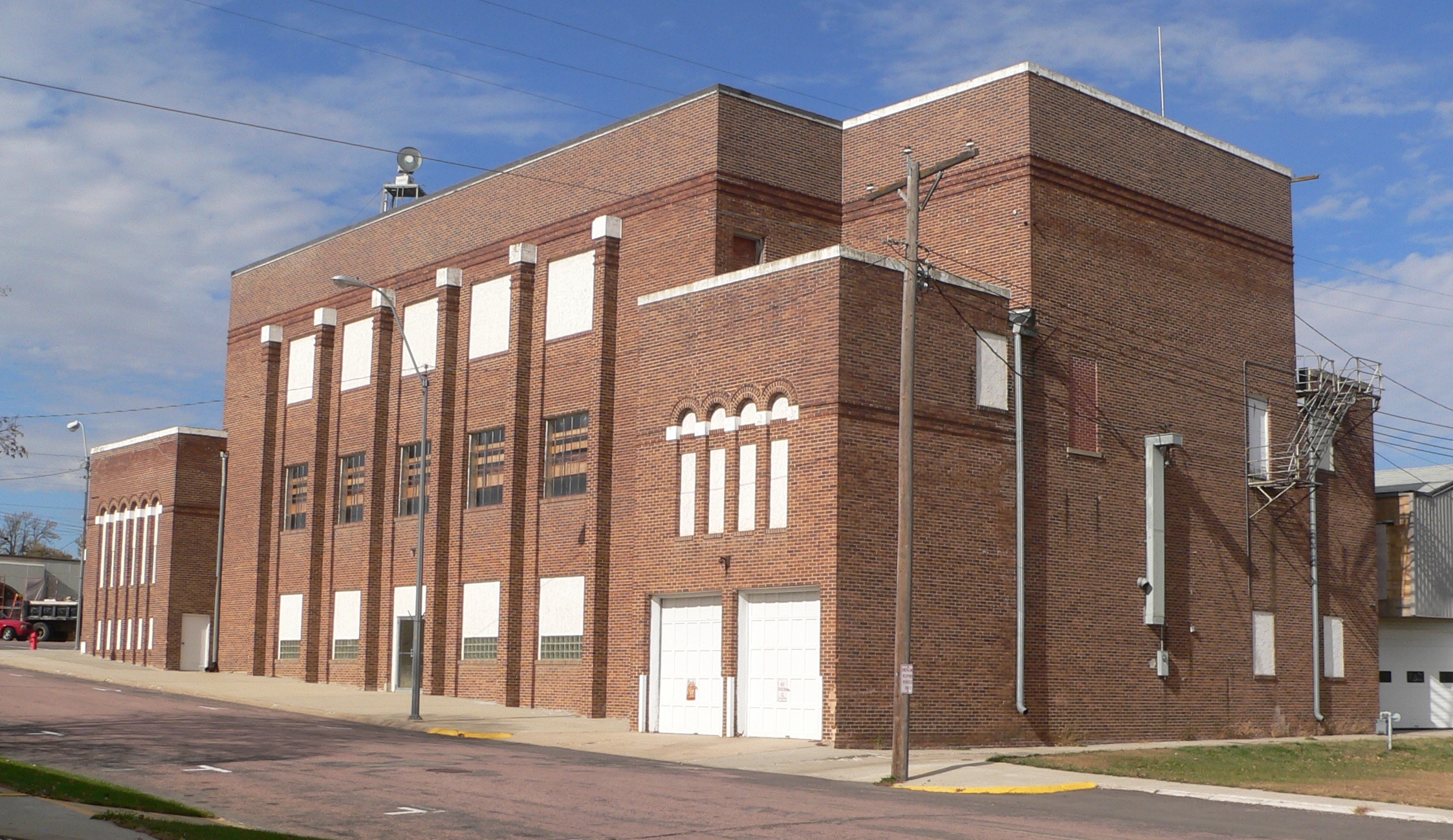 The Hartington City Hall and Auditorium includes three levels: raised basement partially below grade, main level, and upper level. The basement level and main level are basically rectangular in plan, wide (north-south along Broadway) and front to back (east-west along Centre). However, the upper level plan is in the shape of a cross, so that the four corners are one story lower and function as wings. The two front wings project forward toward Broadway as well as laterally (north and south). The two rear wings are flush with the back (east) of the building. The southeast wing projects south and contains the two fire house doors, but the northeast wing does not project north. The basement originally contained the armory including officers’ quarters, lockers, supply room, and sleeping facilities for fire fighters, with the firehouse in back under the auditorium stage. The main level accommodated the lobby and city offices in front, the auditorium's hardwood floor taking up the large middle, and the stage in back above the fire house. The cross-shaped upper level included a small space in front above the lobby and the stage fly space in back, but the bulk of it in the middle was simply open to the auditorium.
As situated at the intersection of Broadway and Centre Streets, the two principal facades are the front (west) facing Broadway and the south facade facing across Centre to the brick Romanesque Revival Cedar County Courthouse. The front facade is two stories above the raised basement. However, Centre Street slopes downward as it moves east away from Broadway, so that the basement level is fully above grade at the back, presenting a three-story east facade.
The Hartington City Hall and Auditorium includes three levels: raised basement partially below grade, main level, and upper level. The basement level and main level are basically rectangular in plan, wide (north-south along Broadway) and front to back (east-west along Centre). However, the upper level plan is in the shape of a cross, so that the four corners are one story lower and function as wings. The two front wings project forward toward Broadway as well as laterally (north and south). The two rear wings are flush with the back (east) of the building. The southeast wing projects south and contains the two fire house doors, but the northeast wing does not project north. The basement originally contained the armory including officers’ quarters, lockers, supply room, and sleeping facilities for fire fighters, with the firehouse in back under the auditorium stage. The main level accommodated the lobby and city offices in front, the auditorium's hardwood floor taking up the large middle, and the stage in back above the fire house. The cross-shaped upper level included a small space in front above the lobby and the stage fly space in back, but the bulk of it in the middle was simply open to the auditorium.
As situated at the intersection of Broadway and Centre Streets, the two principal facades are the front (west) facing Broadway and the south facade facing across Centre to the brick Romanesque Revival Cedar County Courthouse. The front facade is two stories above the raised basement. However, Centre Street slopes downward as it moves east away from Broadway, so that the basement level is fully above grade at the back, presenting a three-story east facade.
 As designed by William L. Steele, the building exhibits primarily Prairie School attributes, but also includes
As designed by William L. Steele, the building exhibits primarily Prairie School attributes, but also includes 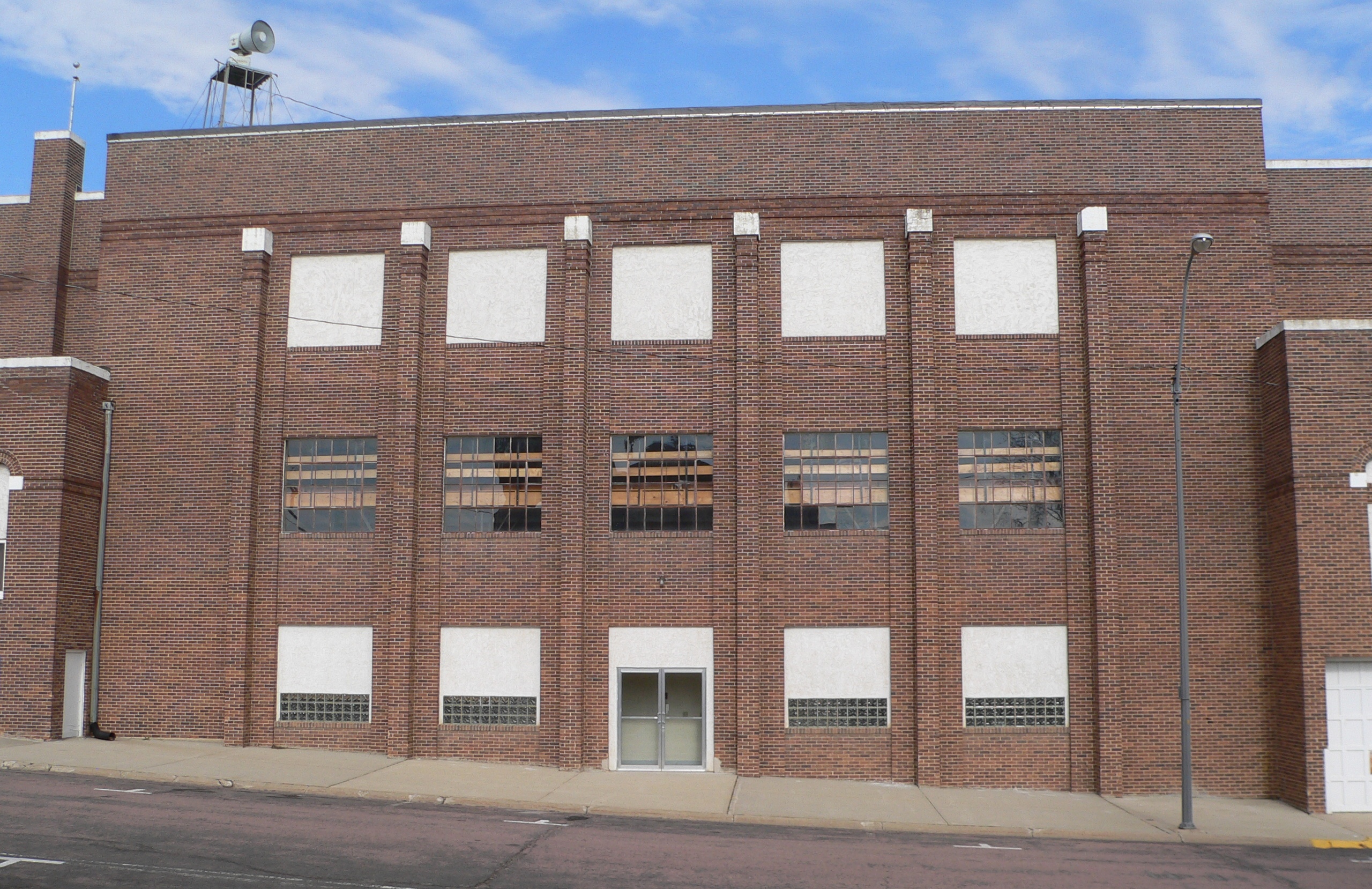 The central bay of the south facade of the Hartington City Hall and Auditorium is highly effective Prairie School architecture (the nearly hidden north facade is similar). The bulk of the wall surface is simple
The central bay of the south facade of the Hartington City Hall and Auditorium is highly effective Prairie School architecture (the nearly hidden north facade is similar). The bulk of the wall surface is simple 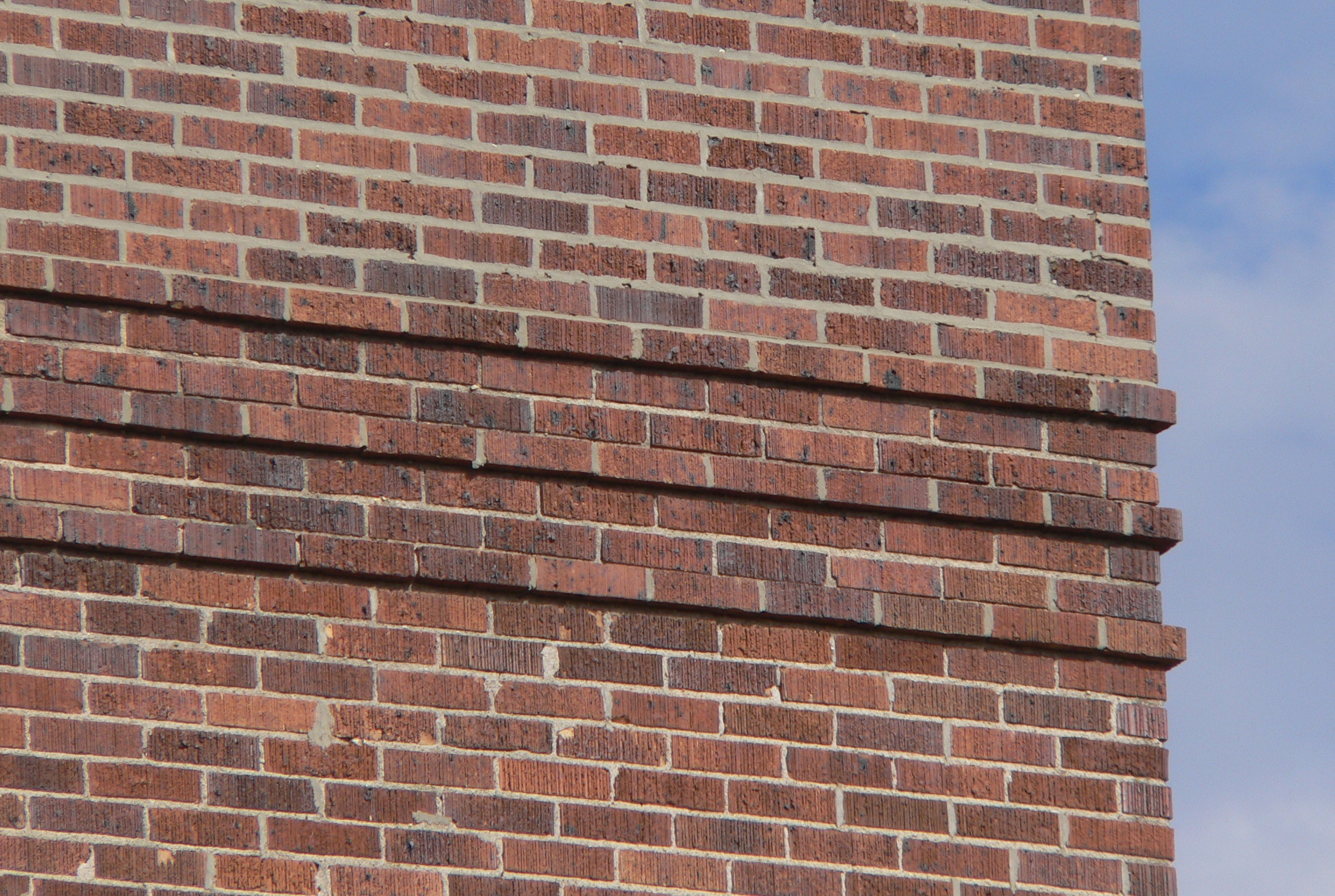 In contrast, although the front facade uses some similar features, it is less integrated, with horizontal, vertical, and circular elements that are attractive, but that do not complement each other and are out of keeping with Prairie Style. In observing similar mixtures of Prairie with other styles, S.J. Klingensmith observed the contrasting styles introduce "tensions that are not completely resolved and indicate that Steele was not committed solidly to the style".
In contrast, although the front facade uses some similar features, it is less integrated, with horizontal, vertical, and circular elements that are attractive, but that do not complement each other and are out of keeping with Prairie Style. In observing similar mixtures of Prairie with other styles, S.J. Klingensmith observed the contrasting styles introduce "tensions that are not completely resolved and indicate that Steele was not committed solidly to the style".
 In their evaluation, James D. Fagler and Joni Gilkerson not surprisingly note the many features in common between the Hartington City Hall and the
In their evaluation, James D. Fagler and Joni Gilkerson not surprisingly note the many features in common between the Hartington City Hall and the
Hartington City Hall and Auditorium
}, National Register of Historic Sites Nomination, from the Nebraska State Historical Society.
Recreation: Hartington Auditorium
City of Hartington, Nebraska. Buildings and structures in Cedar County, Nebraska City and town halls in Nebraska Government buildings completed in 1923 Prairie School architecture in Nebraska William L. Steele buildings City and town halls on the National Register of Historic Places in Nebraska National Register of Historic Places in Cedar County, Nebraska Event venues on the National Register of Historic Places in Nebraska
Hartington, Nebraska
Hartington is a city in Cedar County, Nebraska, United States. The population was 1,514 at the 2020 census.
History
Hartington was platted in 1883, as a water stop on the railroad. It was named for Lord Hartington, who had then recently paid a ...
. It was designed between 1921 and 1923 in the Prairie School style by architect William L. Steele (1875–1949).
Prairie School architecture is rare, and this rural Nebraska specimen is particularly unusual for being designed and built in the 1920s, subsequent to the Prairie Style's rapid loss of popularity after 1914.
The building originally housed city offices, a fire house, an armory, and an auditorium. It is currently used for events, meetings, sports, recreation, and social functions.
History
The land which would becomeCedar County, Nebraska
Cedar County is a county in the U.S. state of Nebraska. As of the 2010 United States Census, the population was 8,852. The county seat is Hartington. The county was formed in 1857, and was named for the Cedar tree groves in the area.
In the ...
was held for thousands of years by various Native American tribes, most recently by the Omaha, with the Ponca
The Ponca ( Páⁿka iyé: Páⁿka or Ppáⁿkka pronounced ) are a Midwestern Native American tribe of the Dhegihan branch of the Siouan language group. There are two federally recognized Ponca tribes: the Ponca Tribe of Nebraska and the Ponca ...
somewhat to the west and the Yankton Dakota
The Dakota (pronounced , Dakota language: ''Dakȟóta/Dakhóta'') are a Native American tribe and First Nations band government in North America. They compose two of the three main subcultures of the Sioux people, and are typically divided int ...
generally north of the Missouri River. On March 16, 1854, the Omaha were forced to surrender Cedar County and most of the rest of their territory, and were restricted to what by 1882 would become their reservation, now primarily within Thurston County, Nebraska
Thurston County is a county in the U.S. state of Nebraska. As of the 2010 United States Census, the population was 6,940. Its county seat is Pender.
In the Nebraska license plate system, Thurston County is represented by the prefix 55 (it had ...
.
Chicago and North Western Railway
The Chicago and North Western was a Class I railroad in the Midwestern United States. It was also known as the "North Western". The railroad operated more than of track at the turn of the 20th century, and over of track in seven states befor ...
) to build westward to Cedar County, which in turn led to the founding of Hartington in 1883. As the railroad reached Cedar County, it first founded Coleridge
Samuel Taylor Coleridge (; 21 October 177225 July 1834) was an English poet, literary critic, philosopher, and theologian who, with his friend William Wordsworth, was a founder of the Romantic Movement in England and a member of the Lake ...
as one of the locations needed every seven to ten miles () for trains to take on water and fuel. After laying down seven more miles of track, the railroad founded Hartington as its next stop, naming it after the English statesman Spencer Cavendish, Marquess of Hartington. In a hotly contested election on January 20, 1885, just less than a year after incorporation, Hartington wrested the county seat
A county seat is an administrative center, seat of government, or capital city of a county or civil parish. The term is in use in Canada, China, Hungary, Romania, Taiwan, and the United States. The equivalent term shire town is used in the US st ...
from St. Helena
Saint Helena () is a British overseas territory located in the South Atlantic Ocean. It is a remote volcanic tropical island west of the coast of south-western Africa, and east of Rio de Janeiro in South America. It is one of three constit ...
, north on the banks of the Missouri River.
For over 35 years, Hartington had no large indoor venue. In 1919, after a series of prosperous years resulting from high grain prices during and immediately after World War I
World War I (28 July 1914 11 November 1918), often abbreviated as WWI, was one of the deadliest global conflicts in history. Belligerents included much of Europe, the Russian Empire, the United States, and the Ottoman Empire, with fightin ...
, voters passed a bond issue of $25,000 for the purpose of erecting a new city hall with multiple uses, including an auditorium. When that amount proved insufficient, a second bond issue of $25,000 was approved in 1920.
University of Illinois
The University of Illinois Urbana-Champaign (U of I, Illinois, University of Illinois, or UIUC) is a public land-grant research university in Illinois in the twin cities of Champaign and Urbana. It is the flagship institution of the Univer ...
(now University of Illinois at Urbana–Champaign), Steele had worked as a draftsman in the offices of renowned progressive architect Louis Sullivan
Louis Henry Sullivan (September 3, 1856 – April 14, 1924) was an American architect, and has been called a "father of skyscrapers" and "father of modernism". He was an influential architect of the Chicago School, a mentor to Frank Lloy ...
from 1887 to 1900, and then in four more conservative offices, before settling in 1904 in Sioux City, Iowa, about east of Hartington. By the time Hartington chose him, he was the most prominent architect in the region.
Known to work in a number of styles, Steele had recently been concentrating on the Prairie School style of architecture originally developed by Frank Lloyd Wright
Frank Lloyd Wright (June 8, 1867 – April 9, 1959) was an American architect, designer, writer, and educator. He designed more than 1,000 structures over a creative period of 70 years. Wright played a key role in the architectural movements o ...
and others inspired by Sullivan. Upon first arriving in the region, Steele had been unable to convince any of his clients to try his progressive designs. However, beginning with his Prairie-influenced Ben and Harriet Schulein House
The Ben and Harriet Schulein House is a historic building located in Sioux City, Iowa, United States. Built in 1913 for a locally prominent Jewish businessman and his wife, the two-story frame structure was designed by local architect William L. ...
(Sioux City, 1913), he had begun tentatively moving in the Prairie School direction.
George Grant Elmslie
George Grant Elmslie (February 20, 1869 – April 23, 1952) was a Scottish-born American Prairie School architect whose work is mostly found in the Midwestern United States. He worked with Louis Sullivan and later with William Gray Purcell as ...
. With Elmslie as principal designer and with some assistance from Elmslie's partner William Gray Purcell
William Gray Purcell (July 2, 1880April 11, 1965) was a Prairie School architect in the Midwestern United States. He partnered with George Grant Elmslie, and briefly with George Feick. The firm of Purcell & Elmslie produced designs for building ...
, Steele had erected the Prairie Style Woodbury County Courthouse
The Woodbury County Courthouse is located at 620 Douglas Street in Sioux City, the county seat of Woodbury County, Iowa, United States. It is regarded as "one of the finest Prairie School buildings in the United States" and has been declared a N ...
(Sioux City, 1915-1918). About northwest in Lake Andes, South Dakota
Lake Andes is a city in, and the county seat of, Charles Mix County, South Dakota, United States. The population was 710 at the 2020 census.
The town took its name from Lake Andes which some say derives its name from a pioneer hunter named Handy ...
, Steele had designed the Charles Mix County
Charles Mix County is a county in the U.S. state of South Dakota. As of the 2020 United States Census, the population was 9,373. Its county seat is Lake Andes. The county was created in 1862 and organized in 1879. It was named for Charles Eli ...
Courthouse (1916-1917), also in the Prairie Style. Steele’s success is particularly noteworthy since the Prairie School was in decline by this time, losing ground rapidly to a resurgence of more conservative styles after about 1914, and particularly after World War I.
National Guard
National Guard is the name used by a wide variety of current and historical uniformed organizations in different countries. The original National Guard was formed during the French Revolution around a cadre of defectors from the French Guards.
Nat ...
armory that doubled as a gymnasium.
Architecture
Plan and principal facades
Prairie School design
Romanesque Revival
Romanesque Revival (or Neo-Romanesque) is a style of building employed beginning in the mid-19th century inspired by the 11th- and 12th-century Romanesque architecture. Unlike the historic Romanesque style, Romanesque Revival buildings tended to ...
elements such as semi-circular arches on many of the windows and doors. These Romanesque elements are not in harmony with the over-all Prairie thrust of the architecture. Architectural historian Richard Guy Wilson ascribes Steele's use of Romanesque elements to an “attempt to personalize the Prairie School idiom” that began with Steele's First Congregational Church (Sioux City, 1916–1918), where he notes that the “two different geometries are not resolved.” Steele persisted with this approach, to the point that Wilson concludes that the “round headed opening became Steele's motif for public buildings.”
Prairie Style architecture was primarily originated by Frank Lloyd Wright
Frank Lloyd Wright (June 8, 1867 – April 9, 1959) was an American architect, designer, writer, and educator. He designed more than 1,000 structures over a creative period of 70 years. Wright played a key role in the architectural movements o ...
, inspired by the ideas of Louis Sullivan
Louis Henry Sullivan (September 3, 1856 – April 14, 1924) was an American architect, and has been called a "father of skyscrapers" and "father of modernism". He was an influential architect of the Chicago School, a mentor to Frank Lloy ...
, who served as mentor to Wright, Steele, and many other practitioners of the Prairie School. As developed by Wright, George Grant Elmslie
George Grant Elmslie (February 20, 1869 – April 23, 1952) was a Scottish-born American Prairie School architect whose work is mostly found in the Midwestern United States. He worked with Louis Sullivan and later with William Gray Purcell as ...
, William Gray Purcell
William Gray Purcell (July 2, 1880April 11, 1965) was a Prairie School architect in the Midwestern United States. He partnered with George Grant Elmslie, and briefly with George Feick. The firm of Purcell & Elmslie produced designs for building ...
, Marion Mahony
Marion Mahony Griffin (; February 14, 1871 – August 10, 1961) was an American architect and artist. She was one of the first licensed female architects in the world, and is considered an original member of the Prairie School. Her work in ...
, Walter Burley Griffin
Walter Burley Griffin (November 24, 1876February 11, 1937) was an American architect and landscape architect. He is known for designing Canberra, Australia's capital city and the New South Wales towns of Griffith and Leeton. He has been cr ...
, and others, the Prairie School of architecture rejected historical revival styles and was inspired by the flat terrain and horizon of the prairies of the Midwest. Prairie Style features crisp, rectilinear geometries with an emphasis on horizontal lines set off by occasional vertical counterpoints. Ornament should develop from the structure itself or express it rather than being added to it as an embellishment, and the architect should rely on construction materials honestly used as themselves, rather than imitating something else. A building's internal structure should determine its exterior and be clearly expressed on the outside, in keeping with Sullivan's famous motto of “form follows function”.
running bond
Brickwork is masonry produced by a bricklayer, using bricks and mortar. Typically, rows of bricks called ''courses'' are laid on top of one another to build up a structure such as a brick wall.
Bricks may be differentiated from blocks by siz ...
brickwork, forming a uniform ground for the interplay of horizontal and vertical lines. The stone coping at the roofline forms the highest horizontal line. Not far below is a horizontal band of triple corbelling that surrounds the building. This effect is created by projecting three courses of brick out farther than the wall below (as in a corbel), repeating it with three more courses of brick, and then repeating it again for the entire rest of the wall up to the copestone. Steele adds depth and interest to this band by varying the projection of each of the three brick courses by facade so that corners highlight one or another course (see photo below). This effective horizontal band is similar to but more sophisticated than what Steele used near the top of his noted First Congregational Church (Sioux City, 1916–1918). Additional horizontal lines derive from the original three bands of windows (particularly prior to more recent window alterations). These consistent horizontal lines are dramatically emphasized by the strong counterpoint of the six vertical piers. Yet even these vertical pilasters have horizontal elements in their capitals, consisting of three horizontal bands of projecting brick string courses (which echo the triple corbelling above) and the contrasting capitals of cast stone on top. Across the set of six vertical piers or pilaster
In classical architecture, a pilaster is an architectural element used to give the appearance of a supporting column and to articulate an extent of wall, with only an ornamental function. It consists of a flat surface raised from the main wal ...
s along the auditorium, these elements create additional horizontal lines.
Woodbury County Courthouse
The Woodbury County Courthouse is located at 620 Douglas Street in Sioux City, the county seat of Woodbury County, Iowa, United States. It is regarded as "one of the finest Prairie School buildings in the United States" and has been declared a N ...
, on which Steele had earlier collaborated with George Grant Elmslie
George Grant Elmslie (February 20, 1869 – April 23, 1952) was a Scottish-born American Prairie School architect whose work is mostly found in the Midwestern United States. He worked with Louis Sullivan and later with William Gray Purcell as ...
. However, they also point to a series of similarities between the Hartington municipal building and Frank Lloyd Wright's earlier Larkin Administration Building
The Larkin Building was an early 20th century building. It was designed in 1903 by Frank Lloyd Wright and built in 1904-1906 for the Larkin Soap Company of Buffalo, New York. The five story dark red brick building used pink tinted mortar and ...
(Buffalo, New York, 1904–1906), an innovative Prairie School office building designed for the Larkin Company, then a major national mail-order firm. Both buildings are primarily inward focused but bring light in, feature steel-frame construction covered with plain red brick surfaces, are trimmed with simple stone copings above, use sculptured piers as the primary ornamentation, and possess facades where the pilasters separating the windows are more pronounced than the windows in between. In both structures, prominent vertical lines are “abruptly terminated at the roof line by the stone course at the top of the heavy pylon-like projections at the corners, along the wings and central bays.”
Significance
The Hartington City Hall and Auditorium “is an outstanding representation of the Prairie Style in Nebraska”. It represents a rare civic Prairie School building, and its importance is heightened given that Steele was able to build such a progressive design at a time when conservative architecture was overwhelming the Prairie Style. After about 1914, interest in progressive architecture in general and the Prairie School in particular waned in the big Midwestern cities, such as Chicago and Minneapolis, that had earlier embraced it. By 1915, H. Allen Brooks states, Prairie School “architects were having difficulty obtaining commissions, despite the fact that the quality of their work remained steadfastly high, and the building industry continued active.” The Hartington City Hall and Auditorium is a good example of Steele's successful construction of Prairie Style buildings. It came at the midpoint of the 18 years during which he designed in that style, from hisBen and Harriet Schulein House
The Ben and Harriet Schulein House is a historic building located in Sioux City, Iowa, United States. Built in 1913 for a locally prominent Jewish businessman and his wife, the two-story frame structure was designed by local architect William L. ...
(Sioux City, 1913) to his Williges Building (Sioux City, 1929–1930), “one of the last manifestations of the ...Prairie Style in the United States.” Steele's ability to persist in selling clients on the Prairie Style at these late dates, especially in rural Nebraska and neighboring South Dakota and Iowa, is remarkable.
See also
* William L. Steele *Woodbury County Courthouse
The Woodbury County Courthouse is located at 620 Douglas Street in Sioux City, the county seat of Woodbury County, Iowa, United States. It is regarded as "one of the finest Prairie School buildings in the United States" and has been declared a N ...
* Prairie School
References
External links
*, from the southwest prior to window alteration, from the Nebraska State Historical Society. *{{usurped,Hartington City Hall and Auditorium
}, National Register of Historic Sites Nomination, from the Nebraska State Historical Society.
Recreation: Hartington Auditorium
City of Hartington, Nebraska. Buildings and structures in Cedar County, Nebraska City and town halls in Nebraska Government buildings completed in 1923 Prairie School architecture in Nebraska William L. Steele buildings City and town halls on the National Register of Historic Places in Nebraska National Register of Historic Places in Cedar County, Nebraska Event venues on the National Register of Historic Places in Nebraska